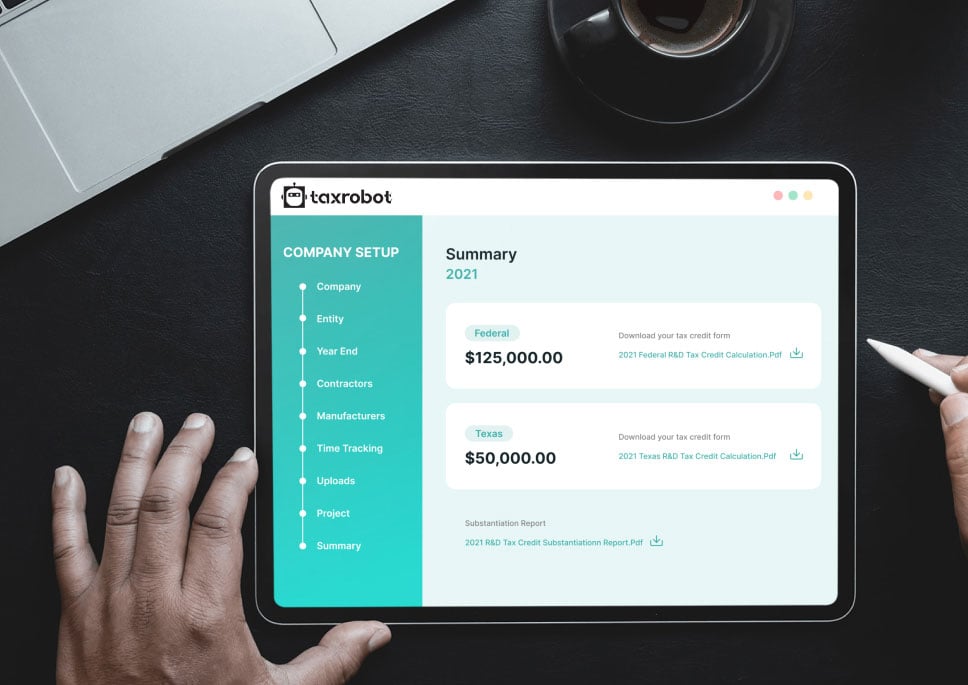South Dakota R&D Tax Credit
At TaxRobot, we’re here to make the process of claiming Research and Development (R&D) tax credits as possible. Our software, powered by artificial intelligence technology, is tailored to help businesses in South Dakota maximize their returns and ensure accurate R&D tax credit claims.
We understand that navigating the complexities of these credits can be challenging. With TaxRobot, you’ll have a user-friendly experience.
Maximize your State Credits today!
Put the R&D tax credit process on autopilot.
Trusted By:








South Dakota R&D Tax Credits
Discover your eligibility for South Dakota R&D tax credits and supercharge your enterprise.
Experience the Power of AI with TaxRobot's R&D Tax Software
With TaxRobot, you can navigate the intricate world of R&D tax credits with ease. Our advanced software seamlessly integrates with your accounting and payroll systems, effortlessly identifying activities and expenses in accordance with the latest guidelines set by the IRS.
Here’s how it works:
- Input Your Information: Tell us about your company and the research and development (R&D) work that it undertakes.
- Connect Your Systems: Let TaxRobot do the heavy lifting as it meticulously identifies qualifying activities and expenditures.
- Claim Your Credits: Get a detailed report of your potential R&D tax credit ready for submission to the IRS.
Why Choose TaxRobot for Your South Dakota Business?
R&D Tax Credit Experts
Our team consists of tax experts who have knowledge of the intricacies surrounding R&D tax credits. We make sure to stay updated on the tax regulations and IRS guidelines so that we can guarantee you receive the utmost advantages.
Audit Support
TaxRobot doesn’t just help you claim your R&D tax credits; we stand by you throughout the process. If your claim is audited, our experts will provide comprehensive support, helping you prepare and present all required documentation.
Value-Based Pricing
We believe in straightforward, transparent pricing. With TaxRobot, you pay for the value you receive. Our pricing model is affordable and flexible, catering to businesses of all sizes.
The Significance of R&D Tax Credit for South Dakota Businesses
R&D tax credits are a tremendous government incentive that fosters innovation in the United States. Businesses operating in South Dakota can significantly benefit from these credits as they have the potential to reduce tax obligations and enhance cash flow substantially.
Stay Ahead with TaxRobot
South Dakota is rapidly becoming a hub for technological innovation, particularly in areas like precision agriculture and biosciences. As the state continues to evolve, the opportunities for claiming R&D tax credits are expanding. TaxRobot stays updated with these changes, ensuring your business doesn’t miss out on any potential credits.
Begin Your Journey with TaxRobot Today
Navigating the unknowns of R&D tax credits doesn’t have to be daunting. With TaxRobot, you have a partner committed to maximizing your R&D tax credits while providing top-notch customer service.
Experience the future of R&D tax credits today. Contact us at TaxRobot and let our AI-driven software and team of experts guide you through the process.
Contact us today for R&D Tax Consultation and get a free estimate.Take a sneak peak

- Limited Time Offer
- Simple Onboarding
- Easy to Use
R&D Tax Credits FAQs
Curious about how far back you can claim R&D tax credits? Well, here's the exciting news: there's no limit! That's right. You can go as far back as 20 years with the R&D credit carryforward period. And guess what? There's no maximum ceiling on the amount you could claim through this tax credit. In fact, some international enterprises are claiming millions per year! Now that's what we call a game-changer.
AI has the power to slash experiment time and resources while boosting the accuracy and reliability of results. Take predictive modeling, for example. AI empowers R&D teams to construct forecasting models that inform decision-making. It's the future of innovation!
If you are engaged in exploring and advancing products, processes, software, or other qualifying innovations within the United States, you might qualify for an R&D tax credit. Your company should have incurred expenses associated with wages, supplies, software, and various other costs during the course of research. Additionally, the research must be intended to create a new or improved product, process, or software. If you fit this criterion, then congratulations! You have the potential to apply for R&D tax credits.
The four-part test as outlined in the Internal Revenue Code is used to determine qualified R&D activity.
The Four-Part Test
1). New Or Improved Business Component
Creation of a new product, process, formula, invention, software, or technique; or improving the performance, functionality, quality, or reliability of existing business component.
- Construction of new buildings or renovation of existing buildings
- Invention of a software application
- Manufacturing of a new product or the improvement of the production process for an existing product
- Creation of design documentation
2). Technological In Nature
The activity fundamentally relies on principles of the physical or biological sciences, engineering, or computer science. A taxpayer does not need to obtain information that exceeds, expands or refines the common knowledge of skilled professionals in a particular field.
- Physics (relationship between mass, density and volume; loading as the
result of gravitational attraction) - Engineering (mechanical, electrical, civil, chemical)
- Computer science (theory of computation and design of computational systems)
3). Elimination Of Uncertainty
Uncertainty exists if the information available to the taxpayer does not establish the capability or method for developing or improving the business component, or the appropriate design of the business component.
- The capability of a manufacturer to create a part within the specified tolerances
- The appropriate method of overcoming unsuitable soil conditions during construction
- The appropriate software design to meet quality and volatility requirements
4). Process Of Experimentation
A process designed to evaluate one or more alternatives to achieve a result where the capability or method of achieving that result, or the appropriate design of that result, is uncertain as of the beginning of the taxpayer’s research activities.
- Systematic process of trial and error
- Evaluating alternative means and methods
- Computer modeling or simulation Prototyping Testing
The R&D tax credit is one of the most misunderstood tax incentives available. Considering the myriad of industries and activities that legally qualify for the credit, the term “research and development” is a misnomer. Additionally, the R&D tax credit requires specialized knowledge and technology to identify and calculate the incentive properly.
Companies of various industries are unaware that they are eligible to claim the R&D tax credit. Under the Internal Revenue Code’s definition of R&D, many common activities qualify. You can get tax benefits for industries including software, technology, architecture, engineering, construction, manufacturing, and more.
The R&D tax credit can be claimed for all open tax years. Generally, open tax years include the prior three tax years due to the statute of limitations period. In certain circumstances, the law allows businesses to claim the R&D tax credit for an extended period of time. It is common for companies to amend previous tax years to claim this benefit and reduce the maximum amount of tax liability.
Partnerships and S corporations must file this form to claim the credit. The credit will flow from the Form 6765, to the Schedule K-1, to the Form 3800 on the individual’s tax return. For individuals receiving this credit that have ownership interest in a partnership or S corporation, Form 6765 is not required on the individual return.
Individuals claiming this credit can report the credit directly on Form 3800, General Business Credit if their only source for the credit is a partnership, S corporation, estate, or trust. Otherwise, Form 6765 must be filed with the individual’s tax return (e.g. sole proprietorship).
For tax years prior to 2016, the credit can be used to reduce the taxpayer’s regular tax liability down to the tentative minimum tax. The credit cannot be used to offset alternative minimum tax. Beginning in tax year 2016, eligible small businesses have expanded utilization for the credit. For these eligible small businesses, the regular tax liability can offset alternative minimum tax using the “25/25” rule.
What our customers have to say
I highly recommend TaxRobot to anyone considering an R&D Tax Credit software to complete their analysis.

We decided to switch to TaxRobot… Best decision we’ve ever made. More affordable, and less complicated.

I couldn’t believe how easy it was! In under an hour, we saved enough money to hire a new employee.
